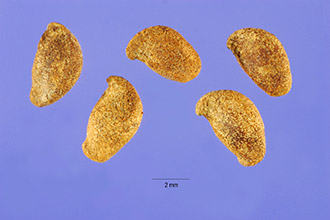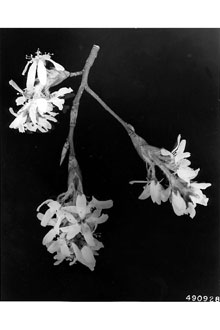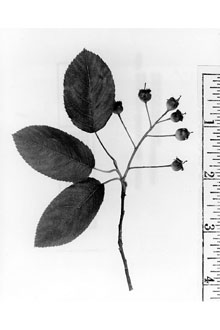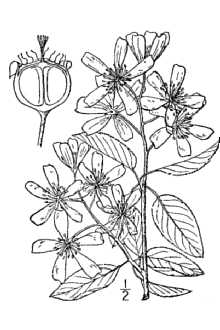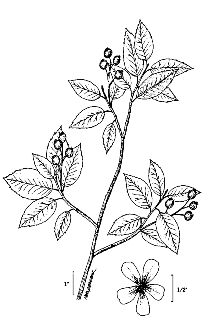Amelanchier canadensis (L.) Medik. var. subintegra Fernald
Scientific Name: Amelanchier canadensis (L.) Medik. var. subintegra Fernald
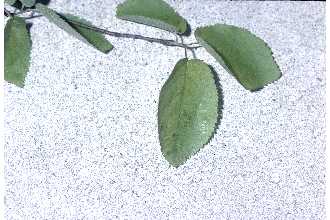
| General Information | |
|---|---|
| Usda Symbol | AMCAS |
| Group | Dicot |
| Life Cycle | Perennial |
| Growth Habits | ShrubTree, |
| Native Locations | AMCAS |
Plant Guide
Alternate Names
Common Names: serviceberry, shadbush, shadblow, sarvice, Juneberry, wild currant Scientific Names: Amelanchier canadensis var. subintegra, Amelanchier lucida
Description
General: Canadian serviceberry is a woody, deciduous shrub native to the US. Shadbush is the common name because its flowering coincides with the annual migration of shad in New England rivers. It has several smooth, gray trunks that grow up to approximately 26 ft tall (8 m) and 15–20 ft (5–6 m) wide. They are ash-gray with dark stripes when young, and rough, with long furrows when older. Its branches slope upward so as to be almost parallel with the main stem. The twigs are hairy when young, becoming smooth with age. They are reddish-brown in the winter and produce reddish-purple leaf buds. The 3–6 cm long and 2–3 cm wide leaves are oblong, finely-toothed, rounded at base, and rounded at the apex with a small, sharp projection. There are 10–15 pairs of main veins. The young leaves are covered with a soft, fine hair and will become dark green and smooth with age. The underside of the leaf is covered with soft white hairs. The leaves will only be half grown during mid-bloom. The nodding inflorescence is indeterminate with many stemmed white flowers branching from a cottony axis. The five showy, oblong to lance-like petals are 7–10 mm (~ 0.5 in) long. The fruit is purplish-black, juicy, and sweet. It is technically a pome (similar to an apple or pear), which is not typical within the Rosaceae family, but it diagnostic of the subtribe Malinae, to which Amelanchier spp. belongs. Serviceberry has a haploid chromosome count of 17, as opposed to other plants in the Rosaceae family which have counts of 7, 8, 9, or 15. Natural populations of serviceberry often hybridize and so may be difficult to distinguish (Bir, 1992). It hybridizes with A. stolonifera, A. intermedia, A. arborea, and A. laevis. Additionally, morphological characteristics in this genus are quite variable. Distribution: Serviceberry grows in USDA hardiness zone 4–7. It can be found in the eastern United States from Maine to Georgia, west to Mississippi and in the eastern parts of Tennessee. For current distribution, please consult the Plant Profile page for this species on the PLANTS Web site. Habitat: Serviceberry is an understory tree, often found growing in clumps in swamps, lowlands, and thickets. It is considered a coastal species of low elevations (Brown and Brown, 1972). In the Northeast, it may be found growing in association with tupelo, speckled alder, poplar, hazel shrubs, white oak, red cedar, choke cherry, and bayberry (Wiggers, 1994).
Adaptation
Canadian serviceberry is designated as a USDA facultative plant meaning that can occur both in wetlands and non-wetlands. It is one of the earliest blooming trees in spring. A study by Abu-Asab et al. (2001) found that the first-flowering of Canadian serviceberry occurred approximately 6 days earlier over a 20-year period in Washington D.C. due to a warming climate. It is moderately drought and salt tolerant and is adapted to many soil types including coarse loamy sands and sandy loams (Gilman and Watson, 1993; Peronto and Manley, 2008; Hightshoe, 1987). Serviceberry is an early-successional plant that will often colonize areas disturbed by storm, fire, or mechanical disturbance (Campbell et al., 1987). In natural communities, Canadian serviceberry forms an association with vesicular arbuscular mycorrhiza (VAM) fungus which helps it acquire mineral nutrients from the soil (Berliner and Torrey, 1988).
Uses
Timber/wood: The wood is hard, heavy, close-grained, and is dark brown with a lighter sapwood (Pinchot and Ashe, 1897). It can hold a polish and can be used to make wooden handles, walking sticks, and fishing rods Natural Resources Conservation Service Plant Guide (Coulber, 2015; Pinchot and Ashe, 1897). Due to the tree’s small size, its use for wood production is limited. Urban forestry/ornamental/shade: Serviceberry has very attractive yellow and gold foliage that turns orange–red in the fall. It is often planted in spring or fall and enjoyed as a specimen tree that is the focal point of the landscape. Its shortcoming is that it may be intolerant to urban heat islands and pollution (Peronto and Manley, 2008). Because of the plants sensitivity to environmental pollutants, it is considered a suitable plant to use as a bioindicator of airborne fluorides (Weinstein and Davison, 2003). Canadian serviceberry may also have difficulty accessing N in urban conditions as indicated by lower foliar N concentrations compared to other popular urban landscaping plants for the Northeast (Falxa-Raymond et al., 2014). Wildlife: Because serviceberry is an early blooming plant, it plays an important role as a food source for pollinators like bees and butterflies. Birds and wildlife are very attracted to serviceberry’s fruit. The fruit may be eaten by orioles, cardinals, thrushes, catbirds, woodpeckers, waxwings, robins, squirrels, and chipmunks (Coulber, 2015; Peronto and Manley, 2008). The larvae of tiger swallowtail butterflies, viceroy, admirals, and striped hairstreak feed on the leaves (Coulber, 2015; Peronto and Manley, 2008). The plant is seldom severely damaged by deer (Drake et al., 2003) Other Uses: Panchen et al. (2012) find that the relatively short flowering period of Canadian serviceberry and its close correlation to temperature makes this plant a good indicator of climate change. The authors also note that the short flowering window allows for more consistency in bloom-time documentation when comparing across herbarium specimens, photographs, and observations.
Ethnobotany
Juneberry pies were made with serviceberry fruit by colonists and Native Americans (Bir, 1992). The Chippewa, Cherokee, and other Native American tribes used the root-bark to cure diarrhea, indigestion, excessive menstrual bleeding, and to expel worms (Foster and Duke, 2000). The fruit can be eaten fresh or dried, cooked for jams, or made into wine.
Status
Weedy or Invasive: Canadian serviceberry is not considered weedy or invasive, and is often promoted as a suitable native alternative to non-native, exotic plants. There is some suckering that will have to be managed in garden plots. Please consult with your local NRCS Field Office, Cooperative Extension Service office, state natural resource, or state agriculture department regarding its status and use. Please consult the PLANTS Web site (http://plants.usda.gov/) and your State Department of Natural Resources for this plant’s current status (e.g., threatened or endangered species, state noxious status, and wetland indicator values).
Planting Guidelines
Serviceberry can be planted in partial to full shade in well-drained acidic, loamy sand (Gilman and Watson, 1993). It has a moderate growth rate. It can be grown from early spring hardwood cuttings and the seed planted in either fall or spring. Microcuttings can be rooted into rockwool plug and out-planted in 6 weeks and ready to be planted into field of garden 8 months later (Chu and Mudge, 1996). If planting by seeds in the spring, the seed will have to undergo cold-moist stratification for 90–120 days (NPIN, 2013). The tree should be watered regularly for the first year of growth, but no nitrogen fertilizer is needed at planting or during the first year of establishment (Peronto and Manley, 2008).
Management
Trees should be regularly irrigated during the first growing season, and thereafter during droughts (Peronto and Manley, 2008). The base of the trunk should have a think bed of mulch 1 inch away from the trunk of the plant. The limbs of will require pruning if planted near sidewalks or roadway, but otherwise, pruning and fertilizing are rarely required (Gilman and Watson, 1993).
Pests and Potential Problems
Serviceberry may be infected by many of the diseases common to plants in the rose family, nevertheless damage to the plant is mostly cosmetic (Bir, 1992). They may be infected by foliar diseases like leaf spot, rust, or powdery mildew. To help prevent leaf spot, fallen leaves should be raked away and overhead irrigation should be avoided. Pests may include Japanese beetles, spider mites, aphids, and leaf miners (Dickert, 2010). The thin bark can be easily damaged by machinery.
Seeds and Plant Production
Plant Production , Use soil moisture sensors to measure the soil moisture of Amelanchier canadensis (L.) Medik. var. subintegra Fernald.
Plant Production
Canadian serviceberry is similar to other plants in the Rosaceae in that it is an apomict (capable asexual seed production) and is also pseudogamous, meaning that both its own pollen and foreign pollen can initiate fruit production (Campbell et al., 1987). A study by Burgess et al. (2014) found that the diploid Canadian serviceberry had a mean 38% fruit set and a mean 18% seed set in open-pollinated flowers; and that outcrossing increased fecundity. Early observations in North Carolina by Pinchot and Ashe (1897) found that within natural communities, serviceberry produced a large fruit set every three years, with intermediate years only producing sparingly. If seeds are collected and stored overwinter, they should first be properly cleaned by removing the seeds’ fleshy coating. Serviceberry also produces suckers and will spread naturally through suckering. Cultivars, Improved, and Selected Materials (and area of origin)
Literature Cited
Abu-Asab, M.S., P.M. Peterson, S.G. Shetler, and S.S. Orli. 2001. Earlier plant flowering in spring as a response to global warming in the Washington, DC, area. Biodiv. Conserv. 10:597–612. Berliner, R., and J.G. Torrey.1988. Studies on mycorrhizal associations in Harvard Forest, Massachusetts. Can. J. Bot. 67(8):2245–2251. Bir, R.E. 1992. Growing and propagating showy native woody plants. The University of North Carolina Press. Chapel Hill, NC. Brown, R.G., and M.L. Brown. 1972. Port City Press. Baltimore, MD. Burgess, M.B., K.R. Cushman, E.T. Doucette, N. Talent, C.T. Frye, and C.S. Campbell. 2014. Effects of apomixes and polyploidy on diversification and geographic distribution in Amelanchier (Rosaceae). Am. J. Bot. 101(8):1375–1387. doi: 10.3732/ajb.1400113 Campbell, C.S., C.W. Greene, and S.E. Bergquist. 1987. Apomixis and sexuality in three species of Amerlanchier, shadbush (Rosaceae, Maloideae). Amer. J. Bot. 74(3):321–328. Chu, C.C., and K.W. Mudge. 1996. Using a rockwool plug system in vitro on Amelanchier, Cercis, Kalmia, cherry, and apple. p. 566. In 93 Annual Conference of the American Society for Horticultural Science, Lexington, KY. 6–10 Oct. 1996. Soc. Hortic. Sci. Alexandria, VA. Coulber, S. 2015. Serviceberries. Canadian
Wildlife
Foundation (CWF). http://cwf-fcf.org/en/discover-wildlife/flora-fauna/flora/serviceberries.html (accessed 10 Mar. 2015). Dickert, G.M. 2010. Serviceberry. Pub. # HGIC 1026. Clemson Coop. Ext. Clemson Univ. Clemson, SC. http://www.clemson.edu/extension/hgic/plants/landscape/trees/hgic1026.html (accessed 13 Mar. 2015). Drake, D., P. Nitzsche, and P. Perdomo. 2003.
Landscape
plants rated by deer resistance. Pub #E271. Rutgers NJAES Coop. Exten. New Brunswick, NJ. Falxa-Raymond, N., M.I. Palmer, T. McPhearson, K. L. Griffin. 2014. Foliar nitrogen characteristics of four tree species planted in New York City forest restoration sites. Urban Ecosyst. 17:807–824. doi:10.1007/s11252-014-0346-3. Foster, S., and J.A. Duke. 2000. Eastern/Central medicinal plants and herbs. 2nd ed. Peterson Field Guides. Houghton Mifflin Co. NY, NY. Gilman, E.F., and D.G. Watson. 1993. Amelanchier canadensis, shadblow serviceberry. Pub # ST–74. USDA US Forest Service Factsheet. UF IFAS Extension. Univ. of FL. Gainesville, FL. http://hort.ifas.ufl.edu/database/documents/pdf/tree_fact_sheets/amecana.pdf (accessed 10 Mar. 2015). Hightshoe, G.L. 1987. Native tree shrubs, and vines for urban and rural America: a planting design manual for environmental designers. John Wiley & Sons. NPIN (Native Plant Information Network). 2013. Lady Bird Johnson Wildflower Center. The Univ. of Texas at Austin. Peronto, M., and R.C. Manley. 2008. Native trees and shrubs for Maine landscapes: shadblow serviceberry. Bull. #2563. UMaine Extension. Bangor, ME. Pinchot, G., and W.W. Ashe. 1897. Timber trees and forests of North Carolina. M.I. & J.C. Stewart. Winston, NC. Weinstein, L.H., and A.W. Davison. 2003. Native plant species suitable as bioindicators and biomonitors for airborne fluoride. Environ. Pollut. 125(1):3–11. doi:10.1016/S0269-7491(03)00090-3 Wiggers, R. 1994. The plant explorer’s guide to New England. Mountain Press Pub. Co. Missoula, Montana. Citation Sheahan, C.M. 2015. Plant guide for Canadian serviceberry (Amelanchier canadensis). USDA-Natural Resources Conservation Service, Cape May Plant Materials Center, Cape May, NJ. Published 03/2015 Edited: May2015 rg For more information about this and other plants, please contact your local NRCS field office or
Conservation
District at http://www.nrcs.usda.gov/ and visit the PLANTS Web site at http://plants.usda.gov/ or the Plant Materials Program Web site: http://plant-materials.nrcs.usda.gov. PLANTS is not responsible for the content or availability of other Web sites.
Plant Traits
Growth Requirements
| Temperature, Minimum (°F) | -33 |
|---|---|
| Adapted to Coarse Textured Soils | Yes |
| Adapted to Fine Textured Soils | Yes |
| Adapted to Medium Textured Soils | Yes |
| Anaerobic Tolerance | Medium |
| CaCO3 Tolerance | High |
| Cold Stratification Required | Yes |
| Drought Tolerance | Low |
| Fertility Requirement | Medium |
| Fire Tolerance | High |
| Frost Free Days, Minimum | 110 |
| Hedge Tolerance | High |
| Moisture Use | Medium |
| pH, Maximum | 7.5 |
| pH, Minimum | 5.5 |
| Planting Density per Acre, Maxim | 1800 |
| Planting Density per Acre, Minim | 700 |
| Precipitation, Maximum | 60 |
| Precipitation, Minimum | 30 |
| Root Depth, Minimum (inches) | 20 |
| Salinity Tolerance | Medium |
| Shade Tolerance | Intermediate |
Morphology/Physiology
| Bloat | None |
|---|---|
| Toxicity | None |
| Resprout Ability | Yes |
| Shape and Orientation | Erect |
| Active Growth Period | Spring and Summer |
| C:N Ratio | Medium |
| Coppice Potential | No |
| Fall Conspicuous | Yes |
| Fire Resistant | Yes |
| Flower Color | White |
| Flower Conspicuous | Yes |
| Foliage Color | Green |
| Foliage Porosity Summer | Dense |
| Foliage Porosity Winter | Porous |
| Foliage Texture | Coarse |
| Fruit/Seed Conspicuous | Yes |
| Nitrogen Fixation | None |
| Low Growing Grass | No |
| Lifespan | Long |
| Leaf Retention | No |
| Known Allelopath | No |
| Height, Mature (feet) | 23.0 |
| Height at 20 Years, Maximum (fee | 20 |
| Growth Rate | Moderate |
| Growth Form | Multiple Stem |
| Fruit/Seed Color | Purple |
Reproduction
| Vegetative Spread Rate | Moderate |
|---|---|
| Small Grain | No |
| Seedling Vigor | High |
| Seed Spread Rate | Slow |
| Fruit/Seed Period End | Fall |
| Seed per Pound | 95708 |
| Propagated by Tubers | No |
| Propagated by Sprigs | No |
| Propagated by Sod | No |
| Propagated by Seed | Yes |
| Propagated by Corm | No |
| Propagated by Container | Yes |
| Propagated by Bulb | No |
| Propagated by Bare Root | Yes |
| Fruit/Seed Persistence | No |
| Fruit/Seed Period Begin | Summer |
| Fruit/Seed Abundance | High |
| Commercial Availability | Routinely Available |
| Bloom Period | Mid Spring |
| Propagated by Cuttings | No |
Suitability/Use
| Veneer Product | No |
|---|---|
| Pulpwood Product | No |
| Protein Potential | High |
| Post Product | No |
| Palatable Human | Yes |
| Palatable Graze Animal | Medium |
| Palatable Browse Animal | High |
| Nursery Stock Product | Yes |
| Naval Store Product | No |
| Lumber Product | No |
| Fodder Product | No |
| Christmas Tree Product | No |
| Berry/Nut/Seed Product | Yes |

